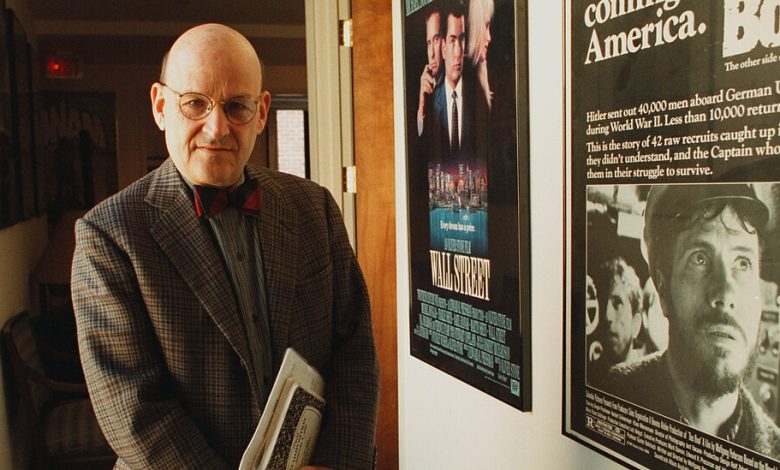Edward R. Pressman, Film Producer Who Boosted Many Careers, Dies at 79

Edward R. Pressman, a prolific film producer who guided some of the earliest movies by Brian De Palma, Terrence Malick, Oliver Stone, Kathryn Bigelow and other leading directors, died on Tuesday in Los Angeles. He was 79.
The cause was respiratory failure, his family said.
Mr. Pressman was producer or executive producer on almost 100 movies across a range of genres. His career began in the late 1960s and by 1988 had already resulted in enough acclaimed films that he was the subject of an 11-movie retrospective at the Museum of Modern Art in Manhattan.
The New York Times said then that he “has been distinguished by his dedication to both highly literate and decidedly quirky movie projects during the last two decades.” And he still had some three decades and more than 60 movies ahead of him.
Mr. Pressman’s name is on films about intriguing real-life figures — “Hoffa” (1992), with Jack Nicholson as the Teamsters boss Jimmy Hoffa; “The Man Who Knew Infinity” (2015), which starred Dev Patel as the Indian mathematician Srinivasa Ramanujan; “Paterno” (2018), the HBO film in which Al Pacino portrayed the football coach Joe Paterno. It is on action fantasies like “Conan the Barbarian” (1982), the movie that brought Arnold Schwarzenegger to stardom. It is on scalding crime dramas like “Bad Lieutenant” (1992) and “American Psycho” (2000).
His biggest claim to fame, especially early in his career, may have been his willingness to take a chance on unproven talent.
One of his first forays as a producer was a movie about a murder that may or may not have been committed by one of two formerly conjoined twins, “Sisters” (1972) — Mr. De Palma’s breakthrough in the creepy crime genre. (Mr. Pressman was also a producer on a 2006 remake, directed by Douglas Buck.) Two years later, he produced Mr. De Palma’s comic drama about a disfigured composer who sells his soul, “Phantom of the Paradise,” which has become a cult favorite.
In between those two he produced the first feature directed by Mr. Malick, “Badlands” (1973), which starred Martin Sheen and Sissy Spacek, both still early in their careers, as criminals on the run. In 1981 he produced the horror film “The Hand,” the first studio feature directed by Mr. Stone.
In 1990 he and Mr. Stone were producers on the crime drama “Blue Steel,” a film by another relative newcomer, Ms. Bigelow; 30 years later she became the first woman to win the directing Oscar, for “The Hurt Locker.” Mr. Pressman also took a chance on David Byrne, the lead singer of Talking Heads, producing Mr. Byrne’s feature debut as a director, the offbeat comedy “True Stories” (1986).
Whatever project he was involved in, Mr. Pressman generally avoided the hands-on approach some other producers favor.
“The hardest thing I’ve learned over the years is that I’m getting paid a lot of money to produce a movie, but sometimes the best thing to do is nothing,” he told The New York Times in 1992, when he was making “Hoffa.” “I don’t need to impose myself.”
Nonetheless, he knew he played a vital role.
“It’s the creative urge that makes me work,” he told American Film magazine for a 1988 article. “The pleasure is, to some extent, vicarious, but it’s no less creative for that. It is creating a world by bringing together creative financing with creative filmmakers. In a sense, producing can be compared to conceptual art.”
Although Mr. Pressman and his company, Pressman Film, worked with major studios, he was partial, especially early in his career, to independent films — movies that were “the expression of a single vision,” as he put it in a 1989 interview with SBS of Australia, like “Badlands,” which was both directed and written by Mr. Malick.
Other times, he viewed his job as bringing together the right director, writer and actor, as with “Hoffa” — he persuaded David Mamet to write a screenplay, recruited Mr. Nicholson to star and, after a few other candidates proved not to be a good fit, made an unconventional choice for director: the comic actor Danny DeVito.
“I think of myself as a catalyst in attracting the key elements,” he told The Times.
And sometimes he was the person who validated a director’s vision, as he was for Ms. Bigelow on “Blue Steel,” which, in addition to directing, she wrote with Eric Red.
“The script for ‘Blue Steel’ was rejected multiple times; the general response was, ‘Could the NYC police officer be a man instead of a woman?’” Ms. Bigelow said by email. “I said, no. Then Ed Pressman agreed. Jaimie Lee Curtis played the officer. Ed offered a lifeline.”
Edward Rambach Pressman was born on April 11, 1943, in Manhattan. His parents, Jack and Lynn (Rambach) Pressman, founded the Pressman Toy Corporation, and, especially after his father died when he was a teenager, there was some expectation that Edward would go into the family business, but his interests veered to other things.
At Stanford University, he studied philosophy, earning a bachelor’s degree in 1965, and he first started thinking about a career in the movie business.
“I had a roommate my senior year whose father was a director,” he told American Film in 1991, “and we’d talk about making films.”
The prospect of actually doing so seemed remote, he said, but it became a reality when, studying for a year at the London School of Economics, he met Paul Williams, a fellow American who was going to Cambridge and who shared his growing interest in films.
“I thought he was, you know, Cecil B. De Mille,” Mr. Pressman said, “and he thought I was Louis Mayer.”
They jointly produced a short that Mr. Williams wrote and directed, “Girl” (1967). Two years later they combined again on a feature, “Out of It,” again written and directed by Mr. Williams; Jon Voigt was in the cast, as he was for Mr. Pressman’s next project with Mr. Williams, “The Revolutionary” (1970).
Mr. Williams had only a limited career after that, but Mr. Pressman was on his way.
His later movies included Mr. Stone’s “Wall Street” (1987), a defining movie of the 1980s. It was while making Mr. Stone’s “The Hand” that Mr. Pressman met Annie McEncroe, who was in the cast (for most of her movie career she was billed as Annie McEnroe); they married in 1983. She survives him, along with their son, Sam Pressman, an executive at Pressman Film; a sister, Ann Markelson; and a brother, Jim.
In addition to advancing the careers of directors and actors, Mr. Pressman advanced a genre: He was big on making movies based on pulp magazine and comic book characters, something that was not as common when he began doing it in the early 1980s as it is today, in the age of digital effects.
“Conan the Barbarian” and its sequel, “Conan the Destroyer” (1984), were based on the pulp character created in the 1930s by Robert E. Howard, and Mr. Pressman’s comics-inspired films included “The Crow” (1994) and several sequels, as well as “Judge Dredd” (1995).
“Comic books, video games, interactive software — these are all areas where artists can create with great freedom and imagination,” he told Business Wire, prophetically, in 1993. “They will be a major part of the motion picture industry’s future.”





